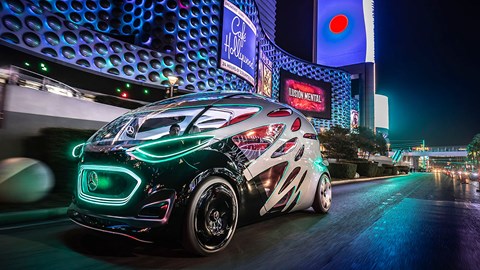► The trends at this year’s show
► CES 2019 has more auto-tech than ever
► Ian Adcock reports
At this year’s Consumer Electronics Show, there was a distinct shift in tone when talking with industry executives and engineers when the thorny subject of autonomous driving was raised.
Gne were the bullish statements about a not too distant future where we would be relegated to mere passengers in our transport pods being effortlessly whisked from home to office, shops and schools.
The fact that PAVE – an acronym for Partners for Automated Vehicle Education – was launched at CES 2019 underlined a new sense of caution about the autonomous future. The coalition which includes Audi, Daimler, VW, NVIDIA, Toyota and Waymo amongst others in its membership aims to educate the public and politicians, legislator’s et al about the benefits of automated driving and dispel much of the confusion surrounding the technology. And about time too.

What are the autonomous car levels?
I have long advocated that self-driving vehicles are more myth than substance; even level three autonomy in which the car will take over from the driver in certain circumstances has been deferred. Two years ago Audi launched its A8 with such technology and to date in the USA its software has never been activated.
It is the transfer of responsibility from car to driver that is causing cold sweats in the industry never mind legislators and the insurance industry, exasperated by a pedestrian’s death last March caused by a self-driving Uber Volvo. There is latency in the reaction time for a driver to regain control if the autonomous technology needs the car to revert to a human driver. It beggars the question, raised by the likes of Toyota, Volvo and Ford that level three ought to be deferred or ignored until more advanced technologies are available.
Living with an Audi A8 L: our long-term review
Technologies such as Far Infra Red (FIR), such as that developed by Israeli start-up, Adasky. Its Viper sensor showcases multi-class detection with a vehicle that simultaneously detects and classifies pedestrians, vehicles, trucks, bicycles, and motorcycles. Viper can also detect and segment animals and other objects in the vehicle’s surrounding environment.

Operating at a different frequency to conventional infra red sensors, it has greater range and sensitivity even to the extent of delineating road markings and kerbs. When included in a suite of technologies including solid state Lidar, radar and cameras it will deliver improved controllability and safer autonomy in strictly regulated conditions such as defined lanes or urban corridors.
How lidar works in an autonomous car
And here we come to another quandary for autonomous vehicles and vehicle to infrastructure (V2X) systems, where is that investment coming from? And whilst 4G is adequate true autonomy will demand 5G networks which is unlikely to roll out in the UK much before the mid 2020s and then only in a limited fashion.
CES as a hotbed of technology might have usurped traditional motor shows like Detroit, but that technology raises as many questions as it provides answers.